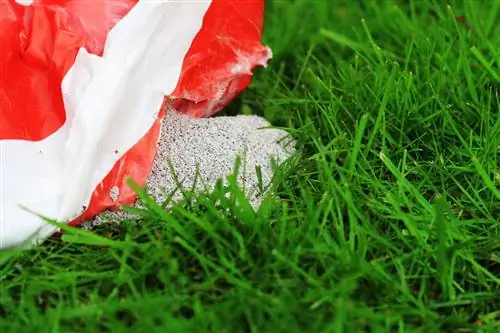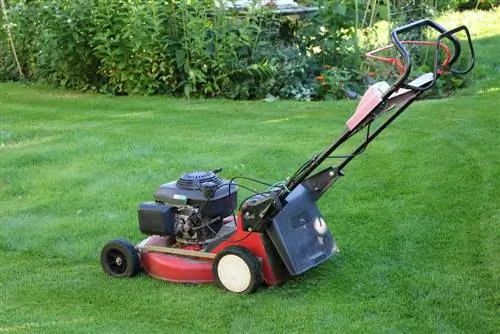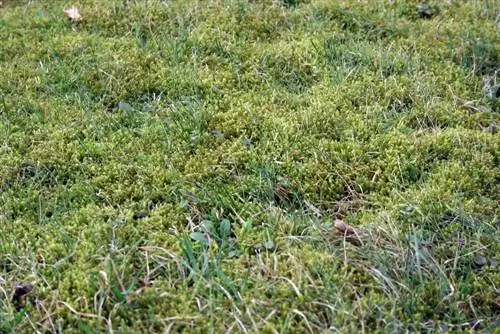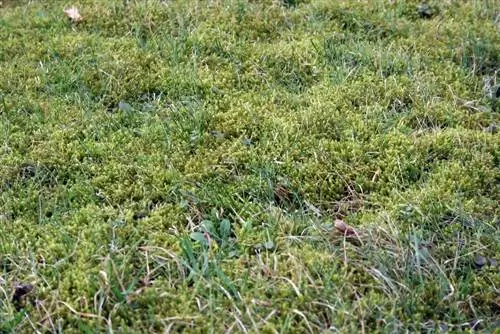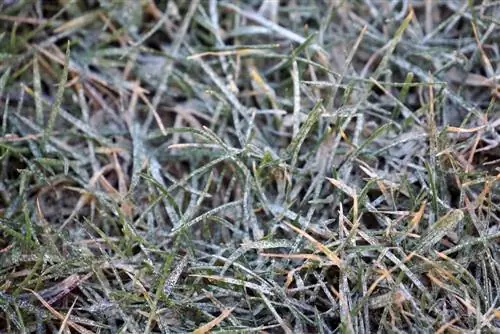- Author admin [email protected].
- Public 2023-12-17 03:39.
- Last modified 2025-01-24 12:45.
Some gardeners spread lime every year, others not at all. The middle ground is liming as needed after measuring the soil pH. The weather plays just as much a role in the application of lime as the right time and the choice of the right lime fertilizer. Because lime alone cannot always drive away the moss in the lawn, sometimes it even promotes it.
Why lime lawns
The cause of increased moss growth can be acidified soil. But it is not necessarily the reason. Therefore, the pH value of the soil should be determined from time to time. If this is in the alkaline range (i.e. above 7) then the soil is not acidic and does not need lime. The cause of moss growth must therefore be looked for elsewhere.
Acid soil
If the pH value is below 6, the soil is acidic. In addition to moss, other weeds also grow on the green area as acid indicators. The blades of grass, however, restrict their growth. Before the lawn is limed, it should not be fertilized. This would only encourage weed growth.
Indicator plants for acidic soil:
- Dog Chamomile
- Small sorrel
- Farmer's mustard
- Hare clover
- Sorrel
- Field Horsetail
- Honorary Award
Suitable pH values for good lawn growth:
- Clay soils not below 6.5
- Sandy loam soils not below 6
- Loamy sand not less than 5, 5
Right time
Basically, the lawn can be limed at any time. However, it works best when the stalks are just starting to grow, i.e. in spring. This is also the time when green spaces are ventilated. Good scarification is a prerequisite for successful liming.
Note:
If the lime could not be applied in spring, liming can also be done in autumn.
The right weather
Rain and wind are ruled out from the start. Wind is very counterproductive, especially when using fine lime, as the lime is blown everywhere and little ends up on the lawn. Dry weather is good for lawn care, but to avoid the need for artificial watering if rain is forecast in the next few days. With the help of the water, the lime gets into the soil and neutralizes it. During liming the sky should be overcast, direct sunlight could damage the roots.
The right lime
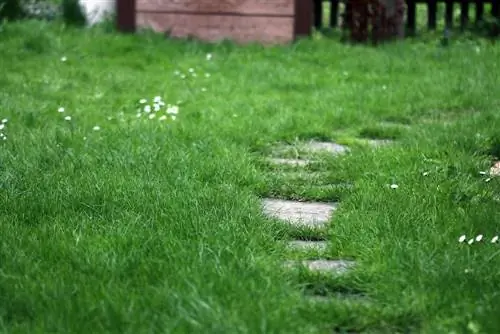
In addition to normal carbonated lime or quicklime, there are also various lime fertilizers commercially available. Rock dust is also suitable for lawns. In addition to lime, it also supplies the grass with other necessary minerals.
- Garden lime In addition to carbonated lime, contains more or less magnesium, suitable for medium and light soils, apply in autumn or winter
- Rock flourandAlgae lime also contain minerals in different compositions and quantities, the effect develops slowly, application possible at any time
- Brightlime and slaked lime, for heavy and medium-heavy soils in agriculture, highly corrosive, be careful when handling
- Lime marl, in addition to lime up to 30% clay content, particularly suitable for improving sandy soils
Maintenance liming and limewashing
If the guideline value is only slightly undercut, it is sufficient if the lawn area is limed approximately every 2 - 3 years with a dosage of around 150 grams per square meter. This keeps the pH value stable and the soil will not acidify further. If the pH value determined is significantly below the standard value, it is necessary to carry out more limewashing. Depending on the type of soil, the amount is between 250 grams (sandy soil) and 500 grams (clay soil). So that the burden on the lawn is not too great, the lime application is divided into two dates. It is best to do them every 6 months.
Tip:
In addition to this dosage, the information on the lime fertilizer packaging can also be helpful. Too much does more harm than too little.
Instructions for applying lime fertilizer
- 1. If you're serious about it, you'll order a soil analysis from a soil laboratory. Otherwise, a simple pH test from a gardening store is sufficient. It is carried out according to the instructions and the pH value is determined.
- 2. The appropriate lime or lime fertilizer is selected. Coarse-grained lime fertilizers are well suited.
- 3. We are waiting for the right weather. Before liming, no lawn fertilizer is used and the lawn is thoroughly scarified. If the grass has already started to grow, it can be mowed again.
- 4. The lime is spread widely by hand or with a spreader. To prevent limescale and skin from coming into contact, wear gloves.
- 5. If the lawn is not evenly limed in places, you can use a rake to help.
- 6. If no rain is expected, water thoroughly now. The lime absorbs into the soil.
- 7. There should be a four-week break before using lawn fertilizer again. The blades of grass should have clearly grown.
- 8. Be careful with alkaline soils, then the pH value (over 7) is too high and you should avoid adding lime.
Indicator plants:
- Stinging Nettle
- Deadnettle
- Shepherd's Purse
9. At the beginning of each new growing season, the pH value is determined and lime is only applied if necessary.
10. If the moss in the lawn does not decrease, but perhaps even increases, you should stop liming and instead consider other causes.
11. In addition to applying lime, sanding the lawn is helpful. Sand loosens the soil layer and helps remove compacted soil.


